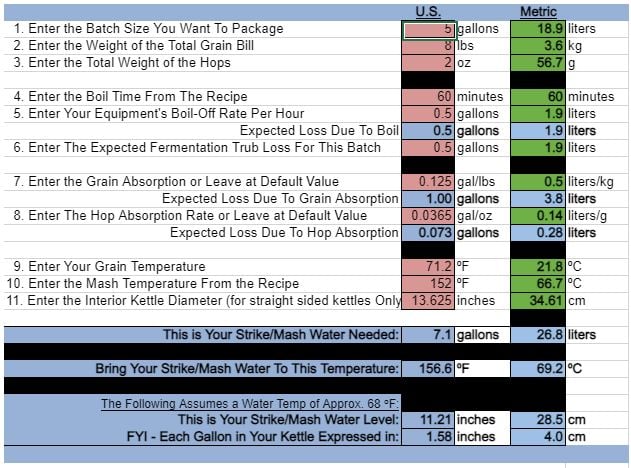We’re going to get back to basics and talk about the volume of water needed for a BIAB brewing session. If you’re an extract brewer and trying to understand the differences between BIAB and extract brewing, the only real difference is what’s being done before the boil begins. Once you get to boiling the wort, it’s the same as extract.
The point of the calculations are to determine how much water is needed to get through entire brewing process all the way to bottling or kegging. If you’re brewing a 5 gallon or 3 gallon batch, it really doesn’t matter – the calculations are the same.
So to get started you need a calculator, and we’re going to use our simple and easy to use BIAB brew-in-a-bag calculator. You’re also going to need a copy of the all grain recipe you plan to brew, you’re brewing set-up’s boil-off rate per hour, grain temperature the day of the brew session, and your kettle’s interior diameter, assuming you don’t have a sight glass to measure your kettle’s water level.
There are a couple of other numbers you will need, which are the expected fermentation trub loss, grain absorption rate and hop absorption rate but I’d suggest just starting out with the calculator’s default values for now and adjust them to what you find works best with your setup after a few sessions.
Understand that you’re going to need a pretty large kettle to brew 5 gallons and also a good heating source too. If you have access to a 7 gallon turkey fryer set-up, then try brewing a 3 gallon batch instead of 5 gallons. You won’t be able to brew a 5 gallon BIAB batch in a 7 gallon kettle.
If you don’t have a sight glass on your kettle and it’s symmetrical and flat bottomed, measure the interior diameter of it, enter it in the calculator and the calculator will tell you what one gallon or liter represents in inches or centimeters so you can simply measure the depth of liquid in your kettle to estimate its volume.
Next, estimate your equipment’s boil off rate per hour. Start by filling your kettle with 5 gallons of water and bringing it to a rolling boil. Once it reaches that point start a timer for 60 minutes. After 60 minutes, kill the flame and let the water cool to about 68 degrees F and figure out what’s left. The difference is the boil off rate. Use a sight glass or measure the depth and use the value from the calculator to convert it to gallons.
Now, go to the calculator and we’ll start plugging in some numbers. First, enter the amount of beer you want to bottle or keg. In this case we’re using 5 gallons but if you scaled your recipe down to 3 gallons, enter 3.

Next, enter the total weight of your grain bill and the total weight of your hops.
From your recipe, enter the boil time in minutes.
Next is your equipment’s boil off rate per hour that you figured out previously. That’s going to give us our expected loss from boiling.
The expected trub loss from fermentation could vary from recipe to recipe so that’s something you’ll dial-in over time, so just use the default value for now. We’ll also keep the default values for the grain and hop absorption rates too.
On brew day, measure the temperature of your gain bill with a thermometer and enter the value. This is important so we can get our strike water temperature high enough to compensate for when we add the cooler grains. We want to get as close as possible to our mash temperature.
You probably already entered your kettle’s diameter earlier to help you figure out your boil-off rate per hour.
So now you know how much water you’ll need and what temperature to bring it to before you add your grain bill. You’ll be able to easily fill your kettle to the right amount of water quickly by measuring its depth. Before I had a sight glass, I used a stainless steel paddle with a stainless hose clamp set to the strike water level and any or marks I wanted to hit while brewing. The calculator will tell you how much a gallon or liter is expressed in inches and cm to make this easier.
Hopefully this helped you understand how to calculate you water requirements so you can get stated with brew-in-a-bag more easily.
Cheers!
